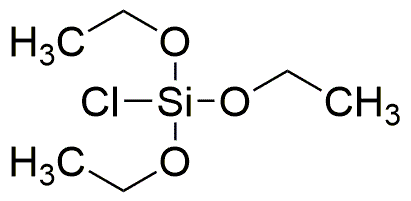Chlorotriethoxysilane is widely utilized in research focused on various applications:
- Surface Modification: This compound is commonly used to modify surfaces of materials such as glass, metals, and ceramics, enhancing their adhesion properties and resistance to moisture.
- Adhesives and Sealants: In the construction and automotive industries, it serves as a key ingredient in adhesives and sealants, providing improved bonding strength and durability.
- Coatings: It is employed in the formulation of protective coatings that offer resistance to corrosion and wear, making it valuable in manufacturing and maintenance sectors.
- Nanotechnology: Researchers utilize it in the synthesis of silica nanoparticles, which are used in various applications, including drug delivery systems and as additives in cosmetics.
- Silane Coupling Agents: As a silane coupling agent, it enhances the compatibility between organic polymers and inorganic materials, improving the performance of composites in industries like electronics and automotive.
General Information
Properties
Safety and Regulations
Applications
Chlorotriethoxysilane is widely utilized in research focused on various applications:
- Surface Modification: This compound is commonly used to modify surfaces of materials such as glass, metals, and ceramics, enhancing their adhesion properties and resistance to moisture.
- Adhesives and Sealants: In the construction and automotive industries, it serves as a key ingredient in adhesives and sealants, providing improved bonding strength and durability.
- Coatings: It is employed in the formulation of protective coatings that offer resistance to corrosion and wear, making it valuable in manufacturing and maintenance sectors.
- Nanotechnology: Researchers utilize it in the synthesis of silica nanoparticles, which are used in various applications, including drug delivery systems and as additives in cosmetics.
- Silane Coupling Agents: As a silane coupling agent, it enhances the compatibility between organic polymers and inorganic materials, improving the performance of composites in industries like electronics and automotive.
Documents
Safety Data Sheets (SDS)
The SDS provides comprehensive safety information on handling, storage, and disposal of the product.
Product Specification (PS)
The PS provides a comprehensive breakdown of the product’s properties, including chemical composition, physical state, purity, and storage requirements. It also details acceptable quality ranges and the product's intended applications.
Certificates of Analysis (COA)
Search for Certificates of Analysis (COA) by entering the products Lot Number. Lot and Batch Numbers can be found on a product’s label following the words ‘Lot’ or ‘Batch’.
Numéro de catalogue
Numéro de lot/série
Certificates Of Origin (COO)
This COO confirms the country where the product was manufactured, and also details the materials and components used in it and whether it is derived from natural, synthetic, or other specific sources. This certificate may be required for customs, trade, and regulatory compliance.
Numéro de catalogue
Numéro de lot/série
Safety Data Sheets (SDS)
The SDS provides comprehensive safety information on handling, storage, and disposal of the product.
DownloadProduct Specification (PS)
The PS provides a comprehensive breakdown of the product’s properties, including chemical composition, physical state, purity, and storage requirements. It also details acceptable quality ranges and the product's intended applications.
DownloadCertificates of Analysis (COA)
Search for Certificates of Analysis (COA) by entering the products Lot Number. Lot and Batch Numbers can be found on a product’s label following the words ‘Lot’ or ‘Batch’.
Numéro de catalogue
Numéro de lot/série
Certificates Of Origin (COO)
This COO confirms the country where the product was manufactured, and also details the materials and components used in it and whether it is derived from natural, synthetic, or other specific sources. This certificate may be required for customs, trade, and regulatory compliance.


